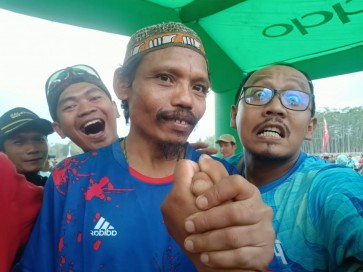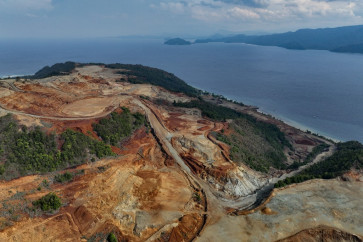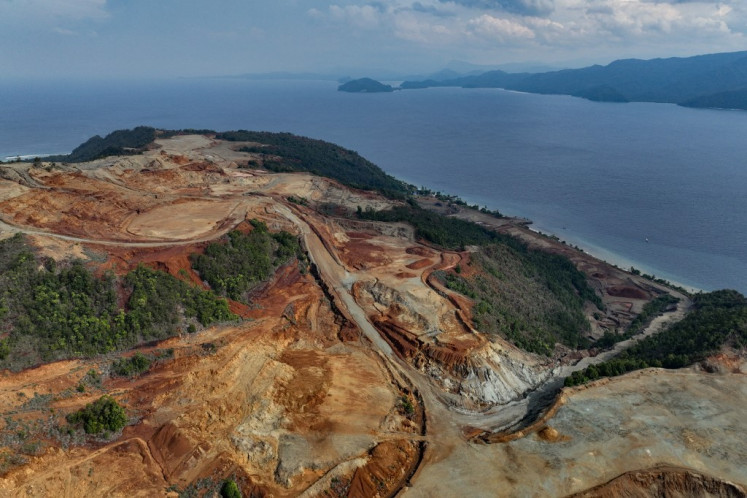The extended family of Meru Betiri National Park
To the horizon: Bandealit Beach is one of the tourist sites mentioned in the Meru Betiri National Park Conservation Partnership
Change text size
Gift Premium Articles
to Anyone

To the horizon: Bandealit Beach is one of the tourist sites mentioned in the Meru Betiri National Park Conservation Partnership.
“Have you ever tried ayam geprek?” asked 74-year old Kliwon, referring to the crispy battered fried chicken that is now popular in many cities.
The dish is made of chicken that is usually mixed with extra hot chili sauce known as cabai setan (satan’s pepper), a variety now being harvested by Kliwon at his plantation.
Kliwon grows cabai setan in his 0.5-hectare plantation as a complement to his main crop, cabai jamu (Javanese long pepper), which is far more profitable. Around 30 plants of this species can be found in his plantation in Curahnongko village, Tampurejo district, Jember, East Java.
“I once harvested 400 kilograms of cabai jamu,” he said.
“The Papuans chew young cabai jamu instead of betel leaves, which they believe can enhance the body’s immune system and heal various illnesses.”
Kliwon also grows common plants like petai (stink beans) and durian. He claimed to have obtained their seedlings from the national park. That afternoon, he picked papaya fruits, after harvesting young jackfruits, bananas, ginger, galingale and other spices to be sold in the Ambulu market, about 10 kilometers from his home.
“The cabai jamu can be harvested next month,” he added.
Kliwon began cultivating the land previously owned by state forestry company Perhutani in 2002 to support his family and seven children.
However, he was always worried that he’d be told to vacate the land, which is located within the TNMB conservation zone. If that were the case, he would have to illegally reclaim other parts of the forests.
“What I’m doing is squatting on this land. And if the authorities say I’m forbidden to work the land, then I will lose my livelihood. But nowadays, squatters can be very productive with the land,” he said.
Kliwon is now affiliated with the Farmer Group Network of Ecosystem Rehabilitation (JAKETRESI) in Tampurejo district, which is composed of 108 farmer groups involving 3,556 families. According to JAKETRESI chairman Sugiri, his network covers a total land area of 2,779.08 ha.
“We started our rehabilitation effort in 1993, long before forest squatting occurred, by combining wood and fruit yielding forest plants such as jackfruit and kluwak [Pangium edule] trees,” Sugiri said.
Squatters entered the park in 1988, exploiting Perhutani’s teak trees and other forest resources, rendering the zone barren.
Sugiri now feels happy, though, with high hopes of rehabilitating the previously unproductive land. He said JAKETRESI members had worked independently to manage their land by growing mixed plants.
Upper stands have mostly been filled with petai, jackfruit, trembesi (rain tree), lamtoro (Leucaena leucocephala) and kluwak, and lower stands with corn, rain-fed paddy, tubers and medicinal herbs.
“Yet we needed a strong legal umbrella and Conservation Partnership responded to our concerns,” he said.

The partnership was introduced to reduce poverty, unemployment and discrepancy in forest management and utilization by giving local communities access to legal management.
The Indonesian Tropical Nature Institute (LATIN) cooperated with Sugiri, Kliwon and their groups from 2007 to promote land rehabilitation, but the activity was halted in 2015.
“The process of guidance declined from 2015, causing farmers to prioritize horticultural and herbal plants, rather than those functioning to rehabilitate land,” said Arif Aliadi, LATIN’s program director.
LATIN said five villages had joined the rehabilitation program, namely Curahnongko, Andongrejo, Sanenrejo, Wonoasri and Curahtakhir.
Arif added that as the communities had cultivated thousands of hectares of the TNMB conservation zone, a solution should be sought to prevent land conflict from developing into a social issue.
Moreover, the National Park Center and the Natural Resources Conservation Center have no authority over community involvement.
“Fortunately, a rule to solve this matter was already issued. The government through the Natural Resources and Ecosystem Conservation [KSDAE] Directorate General announced the KSDAE Directorate General Regulation No.8/2018 on Conservation Partnership,” he pointed out.
Originally, noted Arif, Meru Betiri was a protected forest based on Dutch colonial legislation. In 1967, the zone was designated as a prospective nature reserve and later an area of 50,000 ha was declared a wildlife sanctuary by Agriculture Ministerial Decree No. 276/1972 dated June 6, 1972, with the main aim of protecting Javan tigers.
After a long process, the government finally established it as a national park, based on the Forestry Ministerial Decree No. 277/1997. The zone has a total area of around 58,000 ha, covering two regencies, Jember and Banyuwangi.
At least 10 villages serve as the TNMB’s buffer regions. A majority of the population still depends on this zone as a source of income and food. Additionally, there are two enclave units, PT Bandealit and PT Sukamande Baru, that have a special zone status.
“The management of this vast zone certainly needs the full participation of local residents, and the Conservation Partnership scheme is the most suitable answer. LATIN is going to support the partnership efforts in six national parks in Indonesia,” Arif said.
Environment and Forestry Ministry KSDAE Director General Wiratno said the role of communities would be very decisive in the management of conservation zones and the conservation of natural resources.
“We are an extended family, a mutually supporting system. What Kliwon has done is surely inseparable from this family system.”
Kliwon, he added, had become an inseparable part of 6,293 villages in Indonesia bordering conservation zones. In 2016, the villages had a population of 9.5 million. This total is still added by the KSDAE Directorate General’s partners assisting in conservation management, researchers, practitioners and those concerned over these zones with all their contents and benefits. Even countless species of fauna and flora are part of the extended family.
“The conservation partnership is meant to help members of the extended family. No one is left behind,” Wiratno emphasized.

— Photos by Syafrizaldi
Your Opinion Matters
Share your experiences, suggestions, and any issues you've encountered on The Jakarta Post. We're here to listen.
Thank you
Thank you for sharing your thoughts. We appreciate your feedback.









